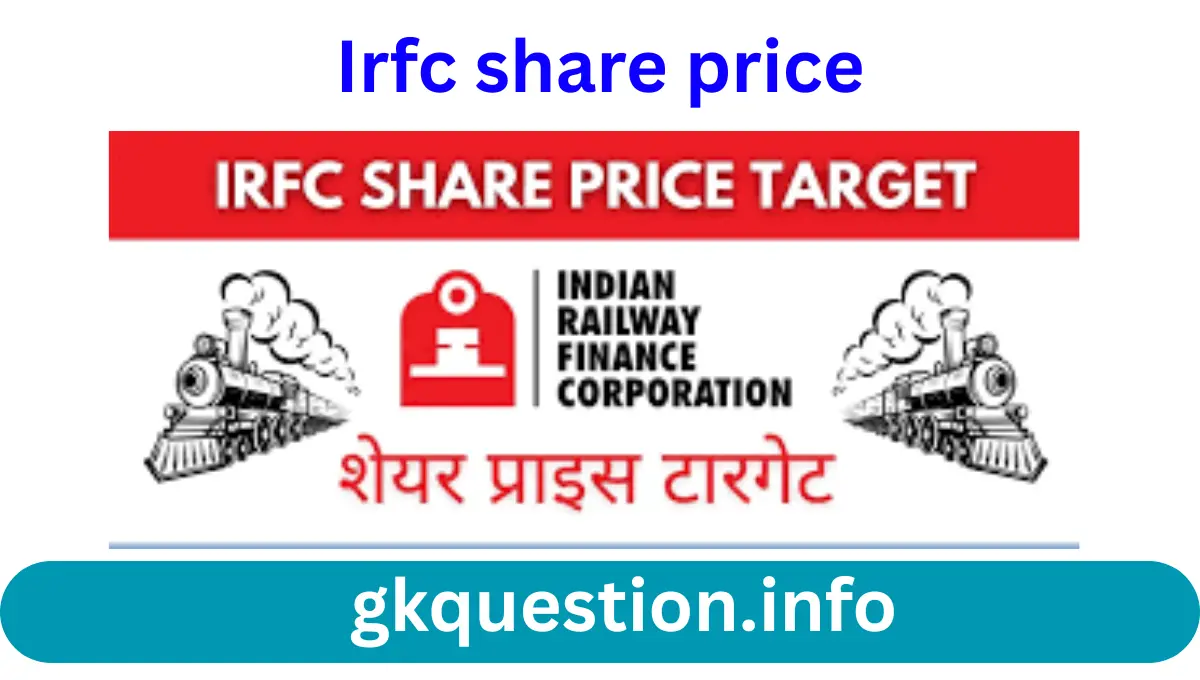IRFC Share Price – If you’ve been following the Indian stock markets, particularly the railway industry, you’ve surely heard of IRFC. The Indian Railway Finance Corporation has been subject to nervous chatter among investors, ranging from old-timers to beginners. Its performance in terms of share price has been a rollercoaster in the truest sense of the word, grabbing headlines and fuelling debates in trading forums and over dinner tables alike.
But why the numbers? Is the IRFC stock price a reflection of long-term national development, or an investment bubble? This article isn’t one of trying to give you an insider tip, but of painting an honest picture of the things that influence this specific stock. Let’s get into it and see the story behind the ticker symbol.
What is IRFC? Understanding the Company Behind the Stock
Before we look into the share price, it is important to know what IRFC precisely does. You cannot judge a book by its cover, and you should not judge a stock by its price chart, too.
IRFC is the specialized financing wing of the Indian Railways. Formed in 1986, its main function is to raise funds in the financial markets to fund the overall infrastructure development and upgradation of the Indian Railways. Imagine it as the treasury department of one of the globe’s biggest railway networks. It doesn’t operate trains or lay tracks itself, but collects money through bonds, loans, and other financial instruments and lends it to the Ministry of Railways.
This business model puts IRFC in the interesting “proxy” position on the Indian infrastructure story. When you buy IRFC, you are essentially wagering on the Indian Railways’ continued growth and capital spending. Its income is primarily from the spread between interest it earns on lending to the railways and the interest it pays on its borrowings. This structure has historically provided it with a stable and low-risk cash stream.
Key Factors Influencing the IRFC Share Price
The movement of IRFC’s stock isn’t random. It’s swayed by a mix of fundamental strengths, market sentiment, and broader economic conditions. Here are the key drivers:
1. Infrastructure Drive by the Government: This is the largest driver. The Indian government’s huge capital spending proposals for the railways, such as new lines, electrification, new stations, and the introduction of Vande Bharat trains, directly benefit IRFC. The company is used as the main source of funding for these projects. Favorable announcements in the Union Budget or new railway projects tend to make investors confident, driving the share price higher.
2. Financial Performance: Ultimately, a company’s well-being shows in its quarterly and annual performance. Investors keep a close eye on:
* Net Profit: Steady growth in bottom-line profit is a good positive indicator.
* Assets Under Management (AUM): Increasing AUM is a sign that IRFC is lending more and more money, which means future interest income.
- Net Interest Margin (NIM): This indicates the profitability of its main lending business. An improving or steady NIM is seen positively.
3. Dividend Payments: IRFC has been paying steady dividends. For income investors, a steady dividend yield makes the stock attractive. Dividend declarations or high yield hopes can be a good support to the share price.
4. Interest Rates and Borrowing Costs: IRFC’s operations are all about borrowing. When the general interest rates in the economy are high, its borrowing cost goes up, which can shrink its margins. A declining interest rate environment is favorable to its profitability.
5. Market Sentiment and Speculation: As with any listed stock, IRFC cannot be shielded from the temperament of the market. A bull phase can lift the stock well above its near-term fundamentals, and a sweeping market correction can drag it down unjustly. Over the past years, it has also been a favorite stock of individual investors, which can sometimes translate into increased volatility based on emotions and trends in social media.
6. Peer Comparison and Valuations: Institutional investors and analysts continuously analyze if the stock is overvalued or under-valued. They compare figures such as Price-to-Earnings (P/E) ratio and Price-to-Book (P/B) ratio with its own past averages and with peers in NBFC (Non-Banking Financial Company) and PSU (Public Sector Undertaking) sectors. A high P/E may indicate that the stock is pricey, and therefore, it could correct in price.
The Recent Rollercoaster: Why the Volatility?
If you’ve glanced at the IRFC share price chart over the last year, you’ve witnessed wild highs and lows. This is due to a few particular reasons:
- The PSU Rally: There was a strong rally in investor interest across all PSU stocks, spurred by government attention, enhanced financials, and compelling valuations. IRFC, being a core PSU, benefited from the trend wonderfully.
- Retail Investor Frenzy: The stock emerged a favourite among retail investors, resulting in huge volumes and momentum-driven buying, which propelled the price to multi-year highs.
- Profit-Booking: With a rise so sharp, naturally, investors want to book their profits. This profit-booking results in price corrections, which is also a natural market phenomenon.
- Budget Expectations and Results: The stock is extremely sensitive to announcements in the budget related to railways. The price may go up based on expectations, and if the announcements fall short of the increased expectations, there will be a sell-off.
Peering Down the Track: A Long-Term Perspective
Attempting to forecast the precise price of any given stock tomorrow or next week is a wild goose chase. The question for a discerning investor is really one of long-term potential.
The narrative for IRFC remains robust. As long as the Indian government continues its massive infrastructure investment, with the railways being a critical component, IRFC’s role as the primary financier is secure. The demand for railway modernization in a growing economy like India is not a short-term trend but a long-term necessity.
But investors can be bracing themselves for a wild ride. The stock is not going to be a smooth, steady ascender. It will continue to experience bursts of explosive growth followed by corrections.
Conclusion
The IRFC share price is more than just numbers flashing on the screen. It’s the story embedded with India’s infrastructure dreams. It provides a unique means to invest in the country’s growth story through a company with a stable, government-backed business model.
For prospective investors, it’s about ignoring day-to-day noise and volatility. Concentrate on the fundamentals of the company, the government’s support for infrastructure, and your own risk tolerance and financial objectives. View it as a possible component of a diversified portfolio, not a short wager.
Do your own research, get to know the business, and if you decide to invest, make it a long-term commitment, prepared to ride out the inevitable tunnels and scenic byways of the market.
Disclaimer: This article is for informational and educational purposes only. It is not a recommendation to buy or sell any securities. Please consult with a qualified financial advisor before making any investment decisions.




